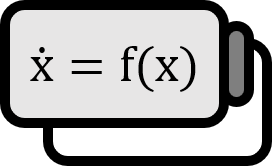Definition of Differential Inclusion
Definition 1
Differential Inclusions
For a multivalued mapping $F : \mathbb{R}^{n} \to \mathbb{R}^{n}$, the expression that the derivative $\dot{x} = dx/dt$ at $x \in \mathbb{R}^{n}$ is one of the elements of the set $F(x)$ is called a Differential Inclusion. $$ \dot{x} \in F(x) $$
Filippov Differential Inclusions
When $f : \mathbb{R}^{n} \to \mathbb{R}^{n}$ is considered a bounded function, the differential inclusion defined for the initial time $t_{0} \in \mathbb{R}$ and initial point $x_{0} \in \mathbb{R}^{n}$ as follows is referred to as Filippov Differential Inclusions. $$ \begin{align*} \dot{x} (t) & \in F(x) \\ x \left( t_{0} \right) & = x_{0} \\ F(X) & = \bigcap_{\varepsilon > 0} \overline{\operatorname{conv} \left\{ f \left( B \left( x ; \varepsilon \right) \right) \right\} } \end{align*} $$ Here, $B \left( x ; \varepsilon \right)$ denotes an open ball, $\operatorname{conv} X$ is the convex hull of $X$, and $\overline{X}$ is the closure of $X$.
Description
Differential Inclusions can be seen as a generalization of ordinary differential equations, especially within the context of dynamical systems, it represents a generic form of nonsmooth systems where for each $x \in \mathbb{R}^{n}$, instead of a single vector forming a vector field, multiple vectors may be associated.
Existence of Solutions
Filippov’s Theorem: For all initial values $x \left( t_{0} \right) = x_{0}$, Filippov differential inclusions have a solution.
The existence of solutions for Filippov differential inclusions is well-established. 2 This theorem is significant because not all nonsmooth differential equations necessarily have solutions. For instance, if we consider the sign function $\sign$ and $a \in (0,1)$, the following differential equation does not have a solution for the initial condition $x_{0} = 0$. $$ \begin{align*} \dot{x} (t) & = a - \sign \left( x (t) \right) \\ x \left( t_{0} \right) & = x_{0} \end{align*} $$
Braun. (2021). (In-)Stability of Differential Inclusions_ Notions, Equivalences, and Lyapunov-like Characterizations: p7. ↩︎
http://tripop.inrialpes.fr/people/acary/Teaching/Ensimag/Lecture3_2020.pdf p45. ↩︎
